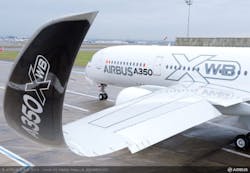Global aerospace plastics market to reach $10.5 billion in 2018, says Transparency Market Research
ALBANY, N.Y., 7 Oct. 2014. The global aerospace plastics market is expected to reach $10.5 billion in 2018, up from a total worth of $6.2 billion in 2011, according to a new market research report published by Transparency Market Research in Albany, N.Y.
Analysts predict the global aerospace market will grow at a compound annual growth rate (CAGR) of 7.9 percent in the 2012 – 2018 forecast, called "Aerospace Plastics Market for Fuselage, Wings and Empennage Applications in Commercial Aircrafts, Military Aircrafts, Rotary Aircrafts, and General Aviation – Global Industry Analysis, Size, Share, Growth, Trends, and Forecast, 2012 – 2018." In terms of volume, aerospace plastic consumption was 40.5 kilo tons in 2011 and is expected to hit 87.8 kilo tons in 2018, rising at a CAGR of 11.7 percent from 2012 to 2018.
Aerospace plastic materials fall under the category of advanced composite materials often known for its efficient modulus of elasticity, heat/flame resistance, and other high-strength physical properties. These plastics are viable alternatives used in military, rotary, freighter planes, and general aviation planes as compared to other conventional materials including steel and aluminum and the inadequate benefits they offer for aviation performance.
Aerospace plastics are extensively used for production of a broad range of aircrafts' components such as decks, cabins, empennages, cockpits, wings, airframes, rotor blades, and many more. Owing to their lightweight, yet state-of-the-art performance abilities, they are an ideal option leading to lowered production costs.
Some key products of the aerospace plastics market – including GRP (Glass Reinforced Plastic), CFRP (Carbon Fiber Reinforced Plastic), and ARP (Aramid Reinforced Plastic) – have enabled the use of aerospace plastics in military, commercial, rotary, and other aircraft applications. They have also enhanced an easy adoption in aircraft design as another characteristic in the aviation industry.
At present, the aerospace plastics constitutes 50 percent of the basic primary structures used in the Airbus A350 and Boeing 787 commercial aircraft. The implementation of aerospace plastics resources is likely to continue and increase in the near future.
Other achievements observed in the aerospace plastics market include excellent strength to weight ratio, stability in the growth of the aviation industry, and rise in the adoption of aerospace plastics in airplane designs. These are some of the poised value-driven factors boosting the growth of this market. Nevertheless, the Greenpeace and EPA (Environmental Protection Agency) regulations imposed on the production of aerospace composite materials are posing a challenge for this market. These organizations implicate that high percentage of greenhouse gases have been monitored at the time of the production of aerospace plastics, which have eventually led us to the harm's way, in terms of ozone layer depletion and other environmental problems. Furthermore, the high costs of raw materials, for instance PAN (Polyacrylonitrile) needed to produce plastics act as a barrier for the growth of this market too.
This study report includes a complete analysis of four key end-user segments including the study of commercial aircrafts segment that accounted for 72 percent of market share in 2011. This end-user segment was then followed by rotary aircrafts, military aircrafts, and other general aviation planes segments. Of all the main segments, fuselage was the chief application segment in the market for aerospace plastics. It accounted for over 28 percent of market share in 2011. In addition, empennage, flight deck, wings, and cabin areas are other key application segments analyzed in this study.
Transparency Market Research is a global market intelligence company, providing business information reports and services.

Courtney E. Howard | Chief Editor, Intelligent Aerospace
Courtney enjoys writing about all things high-tech in PennWell’s burgeoning Aerospace and Defense Group, which encompasses Intelligent Aerospace and Military & Aerospace Electronics. She’s also a self-proclaimed social-media maven, mil-aero nerd, and avid avionics and space geek. Connect with Courtney at [email protected], @coho on Twitter, on LinkedIn, and on Google+.




